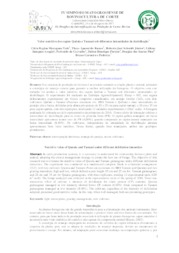Valor nutritivo dos capins Quênia e Tamani sob diferentes intensidades de desfolhação.
Valor nutritivo dos capins Quênia e Tamani sob diferentes intensidades de desfolhação.
Author(s): TESK, C. R. M.; RAMOS, T. A.; SCHMIDT JÚNIOR, R. J.; ARAGÃO, L. S.; CARVALHO, P. de; PEREIRA, D. H.; PINA, D. dos S.; PEDREIRA, B. C. e
Summary: PT-BR: Nos sistemas de produção de bovinos é necessário entender a relação planta x animal, adotando a estratégia de manejo correta para garantir a melhor utilização da forrageira. O objetivo com este trabalho foi avaliar o valor nutritivo dos capins Quênia e Tamani sob diferentes intensidades de desfolhação. O experimento foi realizado na Embrapa Agrossilvipastoril, Sinop ? MT, este seguiu delineamento experimental em blocos completos casualizados, em arranjo fatorial (2x2), com dois cultivares: Quênia e Tamani (Panicum maximum cvs. BRS Tamani e Quênia) e duas intensidades de pastejo: alta e baixa, definidas pela altura pós-pastejo de 15 e 25 cm para capim-tamani; e 20 cm e 35 cm para capim-quênia, com três repetições, totalizando 12 unidades experimentais (120m2 cada). A forragem analisada foi coletada no ciclo representativo da primavera de 2016. Houve efeito de interação cultivar x intensidade de desfolhação para os teores de proteína bruta (PB). O capim-quênia manejado em baixa intensidade apresentou menor teor de PB (6,08%), quando comparado ao capim-tamani manejado em baixa intensidade (8,48%). Os cultivares, independente da intensidade de desfolhação adotada apresentaram bom valor nutritivo. Dessa forma, quando bem manejados, ambos são genótipos promissores. | EN: In cattle production systems, it is necessary to understand the relationship between plant and animal, adopting the correct management strategy to ensure the best use of forage. The objective of this research was to evaluate the nutritive value of Quenia and Tamani guineagrass under different defoliation intensities. The experiment was conducted in a randomized complete block in a factorial arrangement (2x2), with two cultivars: Quenia and Tamani (Panicum maximum cvs BRS Tamani and Quenia) and two grazing intensities: high and low, which defined a post height 15 cm and 25 cm for Tamani guineagrass; and 20 cm and 35 cm for Quenia guineagrass, with three replicates, totaling 12 experimental units (120 m2 each). The forage analyzed was collected in the representative cycle of the spring of 2016. There was interaction effect of cultivar x intensity of defoliation for crude protein (CP) contents. Quenia guineagrass managed in low intensity showed lower CP content (6.08%) when compared to Tamani guineagrass managed at low intensity (8.48%). The cultivars, regardless of the intensity of defoliation adopted, presented good nutritive value. In this way, when well managed, both are promising genotypes.
Publication year: 2017
Types of publication: Paper in annals and proceedings
Observation
Some of Embrapa's publications are published as ePub files. To read them, use or download one of the following free software options to your computer or mobile device. Android: Google Play Books; IOS: iBooks; Windows and Linux: Calibre.
Access other publications
Access the Agricultural Research Database (BDPA) to consult Embrapa's full library collection and records.
Visit Embrapa Bookstore to purchase books and other publications sold by Embrapa.


